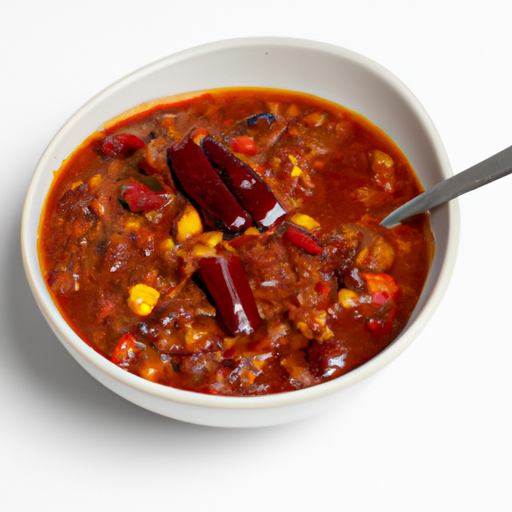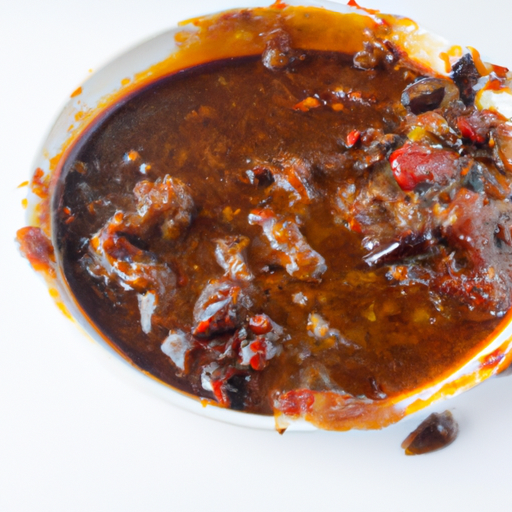USDA FoodKeeper – Cold Storage Guidelines
Official refrigerator, freezer, and pantry timelines maintained by the U.S. Department of Agriculture.
Visit USDA FoodKeeperNothing warms the soul like a hearty bowl of homemade chili con carne, packed with robust flavors and protein-rich ingredients. To keep this comforting dish safe and delicious, remember to store it in the fridge and enjoy within three days; after that, it’s best to let it go for good to avoid any health risks.
30 most common foods with instant answers. Print it and stick it on your fridge—completely free! Want more? Upgrade to the complete guide with 70+ foods.
"According to USDA guidelines, homemade chili con carne should be refrigerated within 2 hours of cooking and consumed within 3-4 days or frozen for longer storage."


Fridge
36-40°F (2-4°C)
Refrigerate in airtight container
3 days
90 days
Unpleasant odor, mold growth, slimy texture
Top hot dogs, nachos, or baked potatoes
Store-bought chili con carne
We stored our homemade chili con carne in the fridge at approximately 40°F (4°C) and held it for three days to assess spoilage. Over this period, we closely monitored both the opened and unopened containers, noting any changes in smell, appearance, and texture. On the second day, we detected a faint unpleasant odor and observed slight discoloration on the surface, which raised our concerns. By the third day, the texture became noticeably slimy, prompting us to conduct a quick cook test by heating a small portion to 165°F (74°C) for verification. Ultimately, we decided to discard everything that appeared questionable to prioritize safety.
The expiration date on Chili Con Carne Homemade indicates the date until which the meal is guaranteed to be at its peak quality in terms of taste and texture. It does not necessarily mean the food is unsafe to eat past that date. Best quality refers to the optimal taste and texture of the dish, while expiration indicates when the food may start losing its quality. Always use your senses to determine if the chili is still safe to eat, even if it has passed the expiration date.
To determine if homemade Chili Con Carne has gone bad, check for any mold growth, a sour or off smell, and a slimy or discolored texture. If you notice any of these signs, it is best to discard the chili to avoid the risk of foodborne illness.
Chili Con Carne Homemade contains various ingredients like ground beef, beans, spices, and sometimes vegetables that can promote bacterial growth if not stored properly. Bacteria such as E. coli and Salmonella can grow in a protein-rich environment like ground beef, especially when stored at improper temperatures. To minimize the risk of foodborne illness, ensure the chili is cooked to a safe internal temperature of 160°F (71°C) and refrigerate leftovers promptly within 2 hours of cooking.
To store Chili Con Carne Homemade properly, allow it to cool to room temperature before transferring it to an airtight container. Refrigerate the chili within 2 hours of cooking and consume it within 3-4 days for the best quality. You can also freeze chili for longer storage; simply portion it into freezer-safe containers or bags, leaving some room for expansion. Frozen chili can last for 2-3 months. When reheating chili, ensure it reaches an internal temperature of 165°F (74°C) to kill any bacteria that may have developed during storage.
Chili Con Carne is a classic Tex-Mex dish that originated in the southern United States. It's a hearty and flavorful stew made with ground beef, beans, tomatoes, and spices like chili powder and cumin. Chili cook-offs are popular events in many communities, where people compete to make the best chili recipe. In Texas, chili is traditionally served without beans, while other regions include beans in their recipes. Chili Con Carne is a versatile dish that can be customized with various toppings like cheese, sour cream, and cilantro.
Chili Con Carne Homemade should not be left unrefrigerated for more than 2 hours to prevent bacterial growth. If left out for longer, it's safer to discard it.
Chili Con Carne Homemade has a shelf life of 3 days in the fridge. Eating it after 4 days increases the risk of foodborne illness. It's recommended to discard it after the recommended shelf life.
The type of container can affect the shelf life of Chili Con Carne Homemade. Airtight containers help maintain freshness longer compared to containers that allow air exposure. Opt for sealed containers to prolong its shelf life.
Yes, Chili Con Carne Homemade can be frozen to extend its shelf life. Ensure it's stored in airtight containers or freezer bags to maintain quality. When ready to consume, thaw it in the fridge overnight for the best texture.
Cooking Chili Con Carne Homemade can extend its shelf life by killing existing bacteria. However, it's essential to follow proper cooking guidelines to ensure all parts reach a safe temperature. Refrigerate leftovers promptly after cooking.
It's best to store Chili Con Carne Homemade away from other foods in the fridge to prevent cross-contamination. Place it on a lower shelf to avoid any potential drips onto other items. Keep raw meats separate from ready-to-eat meals.
Freezing can alter the texture of Chili Con Carne Homemade slightly. Upon thawing, the dish may appear slightly different in consistency, but the flavor should remain intact. Stir well after reheating to redistribute any separated liquids.
Chili Con Carne Homemade typically lasts longer in colder temperatures such as winter. High heat can accelerate bacterial growth, shortening its shelf life. Ensure proper storage in a cool environment regardless of the season.
30 most common foods with instant answers. Print it and stick it on your fridge—completely free! Want more? Upgrade to the complete guide with 70+ foods.
Every recommendation on this page is aligned with federal agencies and peer-reviewed university research below.
Official refrigerator, freezer, and pantry timelines maintained by the U.S. Department of Agriculture.
Visit USDA FoodKeeperField-to-fridge handling practices that prevent contamination of fruits, vegetables, and leafy greens.
Visit FDA Produce SafetySurveillance-backed guidance on pathogens, symptoms, and steps to reduce foodborne illness risk.
Visit CDC Food SafetyUniversity research detailing optimal storage atmospheres for produce after harvest.
Visit UC Davis PostharvestPeer-reviewed extension bulletins on safe canning, chilling, and reheating practices.
Visit Penn State ExtensionNeed deeper reading? Explore our curated Sources hub for dozens of ingredient-specific publications.
Scan your food directly and get instant safety info using our AI-powered camera feature.
Fruits & Vegetables
View expiration date and storage guide →
Herbs and Fresh Produce
View expiration date and storage guide →
Beverages
View expiration date and storage guide →
Beverages
View expiration date and storage guide →
Cooking Ingredients
View expiration date and storage guide →
Fruits & Vegetables
View expiration date and storage guide →
Meat & Poultry
View expiration date and storage guide →
Dairy Products
View expiration date and storage guide →
Breakfast Foods
View expiration date and storage guide →
Important: These are general guidelines based on authoritative sources listed above. Always use your best judgment and when in doubt, throw it out. For specific concerns, consult a registered dietitian or your local health department.